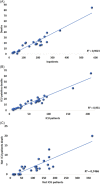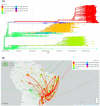COVID-19 pandemic in Southern Brazil: Hospitalizations, intensive care unit admissions, lethality rates, and length of stay between March 2020 and April 2022
- PMID: 35711083
- PMCID: PMC9349601
- DOI: 10.1002/jmv.27942
COVID-19 pandemic in Southern Brazil: Hospitalizations, intensive care unit admissions, lethality rates, and length of stay between March 2020 and April 2022
Abstract
Coronavirus disease 2019 (COVID-19) pandemic spread rapidly with more than 515 million cases and 6.2 million deaths. Epidemiological factors are important for understanding the state of the pandemic. This study aims to evaluate the hospitalizations, intensive care unit (ICU) admissions, and lethality from March 2020 to April 2022. Data were collected from a hospital in Porto Alegre city, southern Brazil. The Mann-Whitney, analysis of variance, and Kruskal-Wallis tests were used to compare quantitative variables. Categorical variables were compared by Pearson's χ2 test. p values <0.05 for all tests were considered significant. Were observed 3784 hospitalizations. Males were 51.4% and the age was 60.4± 20.3. Intensive care unit (ICU) patients were 31.2%, the median length of stay (LOS) was 9.0 and lethality was 13.3%. ICU lethality was 34.5% versus 4.6% in other inpatients (p < 0.01). The LOS of ICU patients was 22.0 versus 7.0 in other inpatients (p < 0.01). The first peak (July-Novemebr 2020) showed ICU occupancy of 79.1%. The second peak (December 2020-June 2021) with 91.6% occupancy. The third peak January-March 2022 with 81.0% occupancy (p < 0.01). Lethality rates were 10.3% in 2020, 14.9% in 2021 and 15.4% in 2022 (p < 0.01). In conclusion, the ICU occupancy rate was higher in 2021 and the lethality rates of ICU patients were high during pandemic years (10.3% in 2020, 14.9% in 2021, and 15.2% in 2022). The lethality of these patients ranged from 25.0% in March to 21.8% in December 2020, from 20.9% in January 22.2% in Decemebr 2021, and 35.7% in January 2022 to 21.4% in April 2022. These data demonstrate that COVID-19 is a critical illness, even in a private hospital setting.
Keywords: COVID-19; intensive care unit; length of stay; lethality.
© 2022 Wiley Periodicals LLC.
Conflict of interest statement
The authors declare no conflicts of interest.
Figures






Similar articles
-
The impact of COVID-19 pandemic on the indications of non-COVID-19 obstetric and gynecological admissions to the intensive care unit (ICU) and its overall consequences.Sci Rep. 2023 Nov 20;13(1):20272. doi: 10.1038/s41598-023-46755-z. Sci Rep. 2023. PMID: 37985824 Free PMC article.
-
Clinical characteristics and outcomes of hospitalized patients with COVID-19 in a city of South Brazil: Have they changed through the first year of the pandemic?PLoS One. 2023 Jun 1;18(6):e0286589. doi: 10.1371/journal.pone.0286589. eCollection 2023. PLoS One. 2023. PMID: 37262056 Free PMC article.
-
Impact Of The COVID-19 Pandemic on Hospital Admissions and In-Hospital Lethality From Cardiovascular Diseases in Brazil: An Ecological and Time Series Study.Curr Probl Cardiol. 2023 Aug;48(8):101216. doi: 10.1016/j.cpcardiol.2022.101216. Epub 2022 Apr 21. Curr Probl Cardiol. 2023. PMID: 35460687 Free PMC article. Review.
-
A retrospective cohort study of 238,000 COVID-19 hospitalizations and deaths in Brazil.Sci Rep. 2022 Mar 7;12(1):3629. doi: 10.1038/s41598-022-07538-0. Sci Rep. 2022. PMID: 35256660 Free PMC article.
-
Clinical Trends Among U.S. Adults Hospitalized With COVID-19, March to December 2020 : A Cross-Sectional Study.Ann Intern Med. 2021 Oct;174(10):1409-1419. doi: 10.7326/M21-1991. Epub 2021 Aug 10. Ann Intern Med. 2021. PMID: 34370517 Free PMC article.
Cited by
-
Stroke Is an Emergency, Even During a Pandemic.Chest. 2023 Mar;163(3):471-472. doi: 10.1016/j.chest.2022.11.017. Chest. 2023. PMID: 36894255 Free PMC article. No abstract available.
-
Nursing workload and severity of COVID-19 patients in the Intensive Care Unit.Rev Esc Enferm USP. 2024 Aug 23;58:e20240107. doi: 10.1590/1980-220X-REEUSP-2024-0107en. eCollection 2024. Rev Esc Enferm USP. 2024. PMID: 39190876 Free PMC article.
References
-
- John Hopkins University of Medicine . Coronavirus Resource Center. Accessed June 06, 2022. https://coronavirus.jhu.edu/map.html
-
- Ministry of Health of Brazil . Painel do coronavirus do Ministério da Saúde do Brasil. Accessed May 13, 2022. https://covid.saude.gov.br/
MeSH terms
LinkOut - more resources
Full Text Sources
Medical
Miscellaneous

